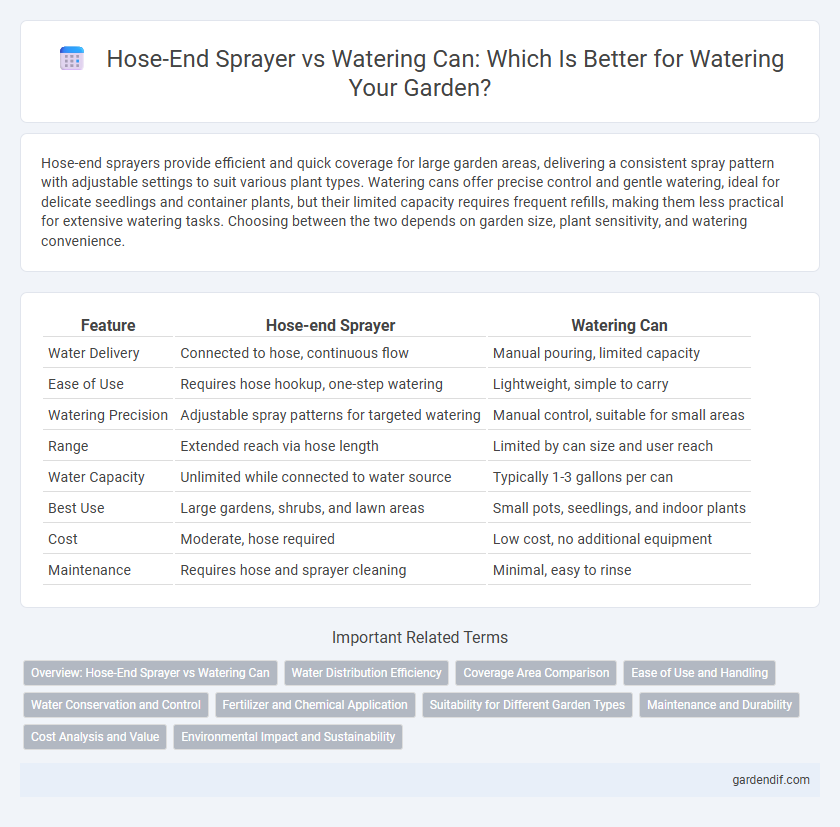
Hose-end sprayer vs Watering can Illustration
Hose-end sprayers provide efficient and quick coverage for large garden areas, delivering a consistent spray pattern with adjustable settings to suit various plant types. Watering cans offer precise control and gentle watering, ideal for delicate seedlings and container plants, but their limited capacity requires frequent refills, making them less practical for extensive watering tasks. Choosing between the two depends on garden size, plant sensitivity, and watering convenience.
Table of Comparison
| Feature | Hose-end Sprayer | Watering Can |
|---|---|---|
| Water Delivery | Connected to hose, continuous flow | Manual pouring, limited capacity |
| Ease of Use | Requires hose hookup, one-step watering | Lightweight, simple to carry |
| Watering Precision | Adjustable spray patterns for targeted watering | Manual control, suitable for small areas |
| Range | Extended reach via hose length | Limited by can size and user reach |
| Water Capacity | Unlimited while connected to water source | Typically 1-3 gallons per can |
| Best Use | Large gardens, shrubs, and lawn areas | Small pots, seedlings, and indoor plants |
| Cost | Moderate, hose required | Low cost, no additional equipment |
| Maintenance | Requires hose and sprayer cleaning | Minimal, easy to rinse |
Overview: Hose-End Sprayer vs Watering Can
Hose-end sprayers offer efficient and even distribution of water mixed with fertilizers or pesticides over large garden areas, saving time and effort compared to traditional watering cans. Watering cans provide precise control for targeted watering, ideal for delicate plants and container gardening but require frequent refills for larger spaces. Choosing between a hose-end sprayer and a watering can depends on garden size, plant types, and the need for fertilizer application alongside watering.
Water Distribution Efficiency
Hose-end sprayers deliver water evenly and cover large areas quickly, optimizing water distribution efficiency for lawn and garden care. Watering cans provide targeted watering suitable for small plants but may result in uneven coverage and slower application. Choosing between the two depends on the size of the area and precision required for effective irrigation.
Coverage Area Comparison
Hose-end sprayers provide extensive coverage areas, making them ideal for large gardens and lawns by delivering an even spray over wide spaces quickly. Watering cans offer precision for small-scale watering tasks, targeting specific plants or confined areas with controlled amounts of water. For efficient irrigation, hose-end sprayers significantly outperform watering cans in both time and coverage capacity.
Ease of Use and Handling
Hose-end sprayers offer greater ease of use by attaching directly to the garden hose, allowing continuous water flow without frequent refills, which makes handling large garden areas more efficient. Watering cans provide precise control for delicate plants but require manual carrying and refilling, making them less convenient for extensive watering tasks. Overall, hose-end sprayers reduce physical effort and improve handling speed compared to traditional watering cans.
Water Conservation and Control
Hose-end sprayers offer precise water control by delivering a consistent spray pattern, minimizing water waste and improving efficiency in watering plants. Watering cans allow for targeted application, ideal for delicate plants or seedlings, but require careful manual control to avoid overwatering. Both methods promote water conservation when used thoughtfully, with hose-end sprayers being more efficient for larger areas and watering cans suited for small-scale or detailed watering tasks.
Fertilizer and Chemical Application
Hose-end sprayers deliver fertilizers and chemicals evenly over large areas, ensuring precise dilution and reducing the risk of over-application. Watering cans offer controlled application ideal for small gardens or potted plants but lack the efficiency for uniform chemical distribution. Choosing a hose-end sprayer optimizes fertilizer absorption and pest control while minimizing waste and environmental impact.
Suitability for Different Garden Types
Hose-end sprayers are ideal for large gardens with extensive plant beds, offering adjustable spray patterns and efficient water coverage, which saves time and effort. Watering cans are better suited for small to medium-sized gardens or container plants, providing precise control over water delivery to delicate foliage and roots. Choosing between the two depends on garden size, plant type, and the need for targeted versus broad watering methods.
Maintenance and Durability
Hose-end sprayers typically require less frequent maintenance due to their durable plastic or metal construction and fewer moving parts compared to watering cans, which often suffer from rust or cracks over time, especially if made of thin metal or plastic. The durability of hose-end sprayers makes them ideal for consistent, long-term garden care, while watering cans may need regular cleaning to prevent algae buildup and occasional replacement due to wear. Proper storage of both tools in a dry, shaded area significantly extends their lifespan by minimizing exposure to harsh weather conditions.
Cost Analysis and Value
Hose-end sprayers generally offer greater cost-efficiency for large garden areas by reducing water waste and minimizing manual labor, despite a higher initial investment compared to watering cans. Watering cans provide affordability and simplicity for small-scale use but can become less practical and more time-consuming as garden size increases. Evaluating the overall value involves balancing upfront costs with water conservation and convenience, where sprayers often deliver higher long-term savings in medium to large gardens.
Environmental Impact and Sustainability
Hose-end sprayers minimize water waste by delivering targeted amounts directly to plants, reducing runoff and evaporation compared to watering cans that often lead to overwatering. Their efficient design supports sustainable gardening practices through precise water usage, conserving resources and lowering environmental footprints. Watering cans, while simple and portable, require more frequent refills and can contribute to inefficiencies if used carelessly, impacting water conservation efforts negatively.
Hose-end sprayer vs Watering can Infographic

 gardendif.com
gardendif.com